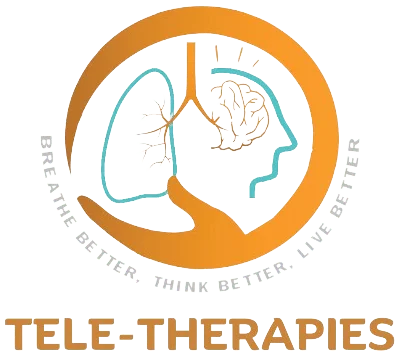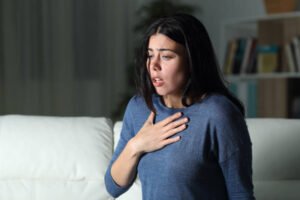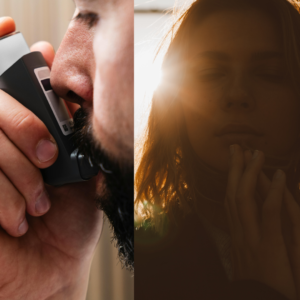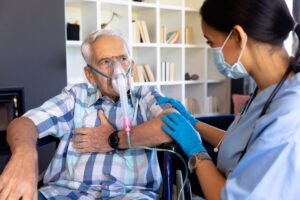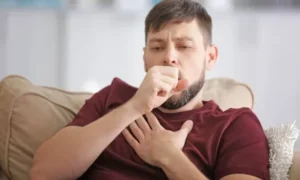Dysfunctional breathing is a highly misunderstood and hard-to-diagnose issue within the medical community. It may be rooted in cardiac problems, POTS, physical exertion, or something as simple as cold weather. Nonetheless, if you’ve ever experienced or have continuing issues with breathing, it’s crucial to seek help and advice from a medical professional. Although it can be challenging to diagnose the reason for dysfunctional breathing, there exist many exercises and methods of rehabilitation that can be used to promote better breathing.
Therefore, this article will walk you through the different causes of dysfunctional breathing, the symptoms you may experience, and the benefits of respiratory rehabilitation or respiratory physiotherapy.
What is dysfunctional breathing?
We’ve touched on this briefly in the introduction, but dysfunctional breathing disorders are abnormal respiratory patterns, often related to over-breathing and breathing more than what the body needs. Additionally, abnormal respiratory patterns can come from mouth-breathing habits, incorrect muscle use, or a reaction to different external stimuli. For example, stressful situations, like a challenging exam or public speaking, can lead to people hyperventilating and suffering from panic attacks. In some cases, the breathing pattern may not return to normal after the high-stress event and leave the individual experiencing anxiety.
Some other potential triggers of dysfunctional breathing include:
- Illness
- Extreme Pain
- Stress
- General Anxiety
This list is not exhaustive, but many possible triggers and reasons for dysfunctional breathing exist. A doctor will want to know when the problem started and the symptoms being experienced, among other tests, before making any guesses at the cause.
Nonetheless, COVID-19 is an illness known to affect respiratory patterns and leave those infected with long-term complications. Asthma is another excellent example of a long-term disease that affects respiratory patterns.
What are some symptoms of dysfunctional breathing?
There exists a wide range of possible symptoms or signs of a breathing pattern disorder that an individual may experience. Some of these symptoms include:
- Headaches
- Panic Attacks
- Dizziness
- Blurred Vision
- Pins and Needles
If you or a loved one are experiencing any of these symptoms, particularly long-term, it is a good idea to book an appointment with your health care provider.
What is respiratory rehab, and how can it help?
Respiratory rehab is a way of retraining yourself to breathe correctly and teaches patients how to pay careful attention to their breathing habits and oxygen levels. This is an excellent option for people that suffer from chronic breathing problems and are looking to lead a healthier life.
The first step to respiratory rehab or respiratory physiotherapy is understanding how breathing works and what you may be doing wrong. It may sound funny that you need to teach yourself to breathe, but awareness is the first step to instituting better habits and breathing.
How can I practice respiratory physiotherapy?
- What is proper breathing?
At rest, optimal breathing is approximately 12-16 breaths per minute. If you want to identify your breathing habit, start by finding a quiet space and lying down. Following this, place a hand on your chest and the other hand on top of your stomach. From here, try to ensure that the rate and size of your breaths are consistent. If possible, it’s recommended to practice this exercise several times per day, particularly if you are experiencing any symptoms or feel they might become present.
- Having good posture and making lifestyle changes.
If you suffer from a chronic breathing issue or dysfunctional breathing, you may need to make lifestyle changes that promote healthier habits. For example, high-intensity activities can lead to breathlessness, which can be a scary experience. It’s important to understand your body and what activities may lead to these symptoms.
Postural syndrome or poor posture is another reason that you may be experiencing breathing issues. If your body lacks movement or is constantly being unnaturally positioned, whether from hunching over a computer screen at a desk or a general lack of exercise, you may experience breathing issues, among other problems. To avoid this, learn to have good posture when sitting and make an effort to participate in activities like hiking, sports, or walking to keep your body mobile and healthy.
- Countering sleeping issues.
For many, breathing issues can be the biggest challenge when falling asleep in the evening. It may be keeping you up at night or waking you up early in the morning. If dysfunctional breathing is disrupting your sleep, you can consider trying some of these practices:
- Practice breathing during the day, and your body will remember it during sleep.
- Find a way to relax before going to bed. This could be activities like reading a book or meditating.
- Avoid caffeinated beverages or foods before going to sleep.
- Do whatever you can to reduce stress.
Final Thoughts
Dysfunctional breathing will occur in many people’s lives, and without proper guidance, it can have some adverse effects on your lifestyle. This has become an especially prominent issue since the COVID-19 pandemic as more people are forced to live with irregular breathing patterns. That being said, respiratory rehab or respiratory physiotherapy is known to help with breathing disorders while promoting healthier lifestyles.
Bibliography:
“The Basics of Pulmonary Rehabilitation.” American Lung Association, https://www.lung.org/lung-health-diseases/lung-procedures-and-tests/pulmonary-rehab.
“Breathing Pattern Disorder.” Long COVID Physio, 2021, https://longcovid.physio/breathing-pattern-disorders.
“Breathing Pattern Disorders – UHS.” Breathing Pattern Disorders, 2021, https://www.uhs.nhs.uk/Media/UHS-website-2019/Patientinformation/Respiratory/Breathing-pattern-disorders-patient-information.pdf.
Hyun, Leo. “Postural Syndrome & Posture Correction.” The Brisbane Spine Clinic, 6 Dec. 2021, https://www.brisbanespineclinic.com.au/spinal-conditions/postural-syndrome/.
